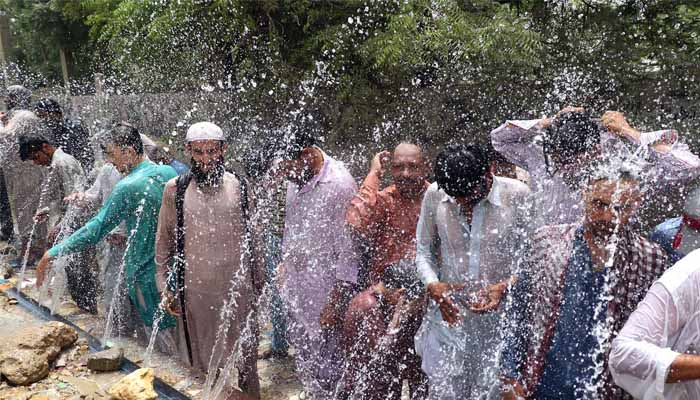At 46°C, city suffers hottest day in May since 1981
At 46 degrees Celsius, Karachi on Wednesday suffered the hottest day in May since 1981, when the mercury had soared to as high a temperature.
Prolonged electricity outages and water shortage in many parts of the metropolis compounded the miseries of the city’s people, as a man reportedly died and several others were taken to hospitals with the complaint of heat exhaustion.
“The temperature soared to 46°C today [on Wednesday] after May 1981, when Karachi’s temperature had also touched 46°C,” Met Office Karachi chief Abdur Rashid told The News. “This was the peak of the current heatwave, as we are expecting the temperature to start decreasing from tomorrow [Thursday].”
Rashid said the temperature is expected to remain between 40°C and 42°C in the city on Thursday, while the current heatwave will end by Friday, adding that the weather will remain very hot until June 15-20.
Pakistan is in the grip of an intense heatwave that is concentrated in Southern Punjab, Sindh and Balochistan, as the weather remained very hot and dry in many cities, with Sibbi being the hottest place in the country as it baked at 49°C, said Pakistan Meteorological Department (PMD) officials.
According to PMD Director General Dr Ghulam Rasool, large areas of Pakistan and India are in the grip of an intense heatwave due to the formation of a large, high pressure area that is responsible for increasing temperatures in both countries. He warned that the current spell of intense heat will continue for the next five to six days in most parts of Pakistan.
As far as Karachi is concerned, small low pressure areas are responsible for the suspension of sea breeze to the metropolis that are frequently being formed in the Arabian Sea due to increasing sea surface temperature and climate change.
More spells of heatwaves can be expected in the city as well as in the coastal areas of Sindh and Balochistan in June, which is usually a hot month in Pakistan.
Miseries compounded
Met Office city chief Rashid blamed the enhanced greenhouse effect, the urban heat island effect and the lack of tree cover as well as prolonged electricity outages and water shortage for compounding the miseries of the people of Karachi.
He said a major shift in urban planning is required in the metropolis to mitigate the effects of climate change, otherwise the city will become very difficult to live in.
“We lack a comprehensive tree cover in Karachi and we are also facing the worst urban heat island effect at the moment, so we don’t have trees that help in lowering the temperature of an area while our jungle of concrete is trapping heat and resulting in extreme miseries and hardships for the dwellers of the city.”
The urban heat island effect is produced when concrete structures in an area continue to trap heat during the day and release heat during the night, keeping the area warm even at night and continuing the cycle for several days. These tall and complex structures also trap hot air and do not allow fresh air to cool down the place.
Heat exhaustion
A young man reportedly died due to heat exhaustion in Karachi’s Khamiso Goth near Ahsanabad in Sohrab Goth, said health officials, while several people were taken to the emergency departments of different hospitals but were later discharged after they were provided first aid.
“A young man has reportedly died according to his parents, but his body was not brought to any hospital,” said Dr Birbal Genani, senior director of the Karachi Metropolitan Corporation’s Medical & Health Services. “But several people reported at different hospitals with the complaint of heat exhaustion. They were given first aid and discharged.”
Jinnah Postgraduate Medical Centre Executive Director Dr Seemin Jamali said they too received a few patients complaining of heat exhaustion and they were provided first aid, but none of them was in a serious condition.
No power, no water
People in many parts of the metropolis complained of prolonged and unannounced electricity outages since Tuesday night. They said when they reported these outages to the K-Electric, they were informed that these were local faults and their teams were attending to them.
“There was hardly any electricity in our area since last night, and whenever we spoke to a KE representative, they said these were local faults and teams were working to resolve them,” said a resident of Gulshan-e-Iqbal, adding that there is nobody in Karachi to take care of the citizens and the power utility is not in anyone’s control.
On the other hand, water shortages were also reported from different areas of the city on Wednesday amid the high temperature. People were seen running from pillar to post in search of water tankers so they could provide the most essential commodity to their households.
-
 Meghan Markle Set To Take Big Decision On Returning To UK For Invictus Games
Meghan Markle Set To Take Big Decision On Returning To UK For Invictus Games -
 Prince Harry To Leave Britain One Day Earlier Than Expected For THIS Reason
Prince Harry To Leave Britain One Day Earlier Than Expected For THIS Reason -
 The Way You Consume Sugar Could Be Affecting Your Health
The Way You Consume Sugar Could Be Affecting Your Health -
 Brooklyn Beckham Gets Backing From Vanessa Marcil Amid Feud With Parents
Brooklyn Beckham Gets Backing From Vanessa Marcil Amid Feud With Parents -
 OpenAI Uses AI To Detect Under 18 Users On ChatGPT
OpenAI Uses AI To Detect Under 18 Users On ChatGPT -
 Philippines To Lift Ban On Grok AI After Musk's Platform Commits To Fix Safety Concerns
Philippines To Lift Ban On Grok AI After Musk's Platform Commits To Fix Safety Concerns -
 Trump Vows ‘no Going Back’ On Greenland Ahead Of Davos Visit
Trump Vows ‘no Going Back’ On Greenland Ahead Of Davos Visit -
 Alexander Skarsgard Breaks Silence On Rumors He Is Bisexual
Alexander Skarsgard Breaks Silence On Rumors He Is Bisexual -
 King Charles Faces Rift With Prince William Over Prince Harry’s Invictus Games
King Charles Faces Rift With Prince William Over Prince Harry’s Invictus Games -
 Elon Musk’s Critique On ChatGPT Safety Draws Sharp Response From Sam Altman
Elon Musk’s Critique On ChatGPT Safety Draws Sharp Response From Sam Altman -
 Katherine Ryan Takes Aim At Brooklyn Beckham In Fierce Defense Of His Parents
Katherine Ryan Takes Aim At Brooklyn Beckham In Fierce Defense Of His Parents -
 How Timothy Busfield, Melissa Gilbert Really Feel After Release From Jail
How Timothy Busfield, Melissa Gilbert Really Feel After Release From Jail -
 OpenAI, Bill Gates Launch ‘Horizon 1000’ To Transform AI Healthcare In Africa
OpenAI, Bill Gates Launch ‘Horizon 1000’ To Transform AI Healthcare In Africa -
 Prince Harry Receives Praises For Exposing Dark Side Of British Tabloids
Prince Harry Receives Praises For Exposing Dark Side Of British Tabloids -
 Andrew Forces Beatrice, Eugenie To Lose $60 Million Safety Net Saved For Retirement
Andrew Forces Beatrice, Eugenie To Lose $60 Million Safety Net Saved For Retirement -
 Nvidia CEO Jensen Huang To Visit China To Push Re-entry Into AI Chip Market
Nvidia CEO Jensen Huang To Visit China To Push Re-entry Into AI Chip Market




